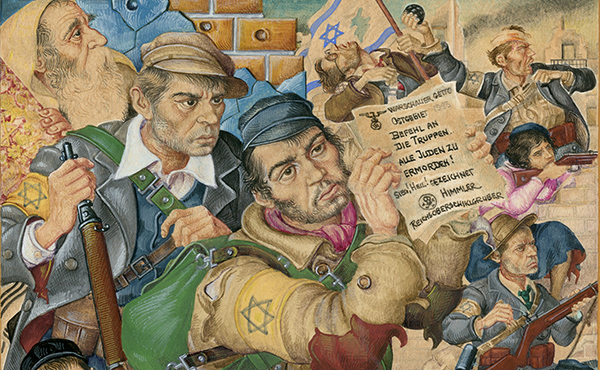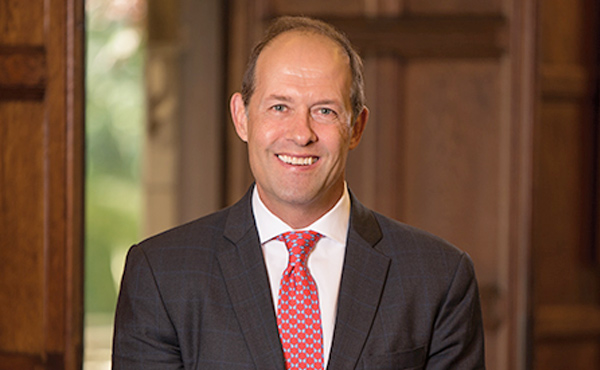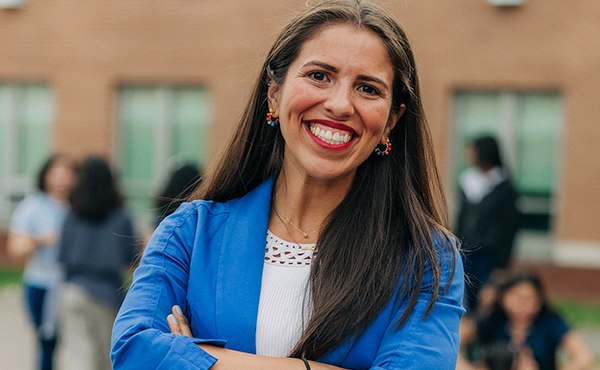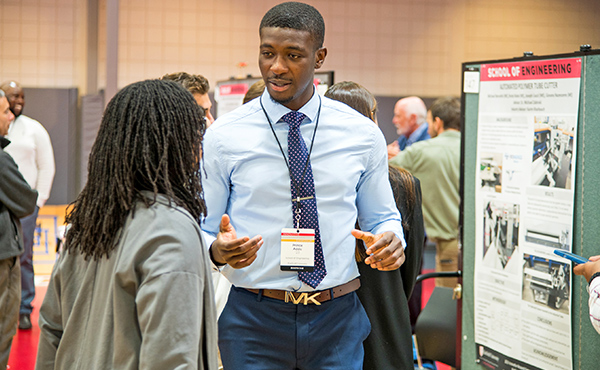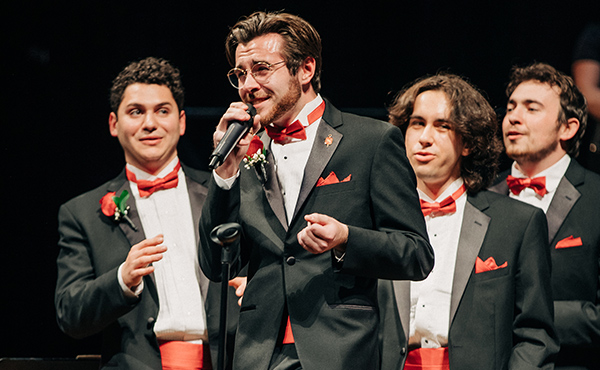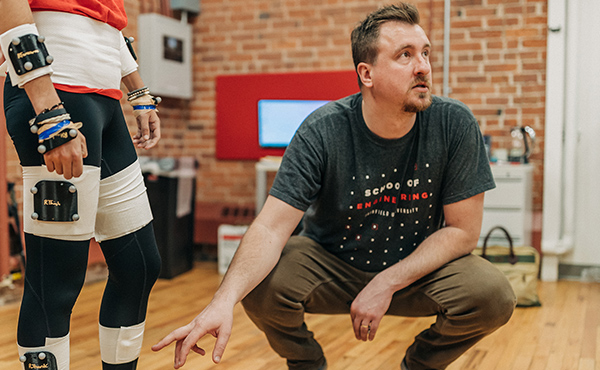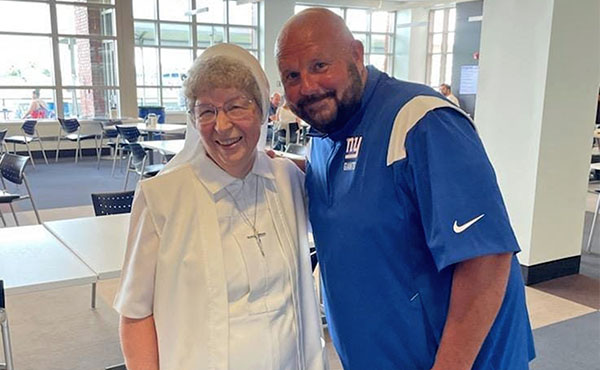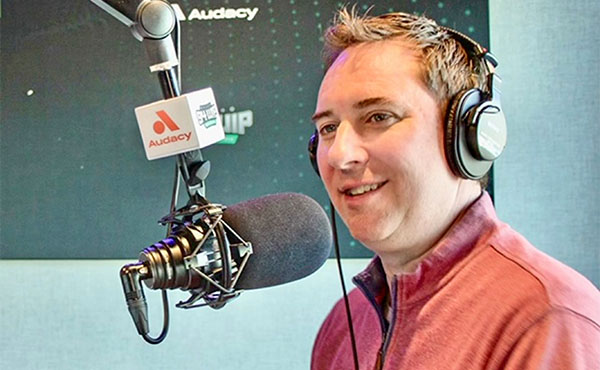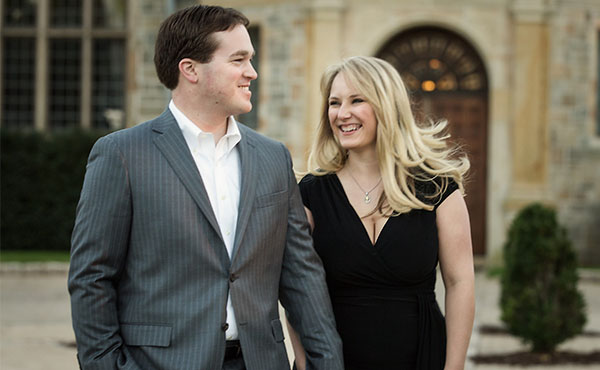Fighting fascism through his illustrations, New Canaan-based artist Arthur Szyk was a prophetic genius of the 1940s. A major new exhibition at the Fairfield University Museum of Art gives his work a long overdue examination.
Szyk’s Anti-Axis cartoons were more popular among the allied soldiers than pinup girls.
— Esquire Magazine
Though Arthur Szyk (1894-1951) died more than 70 years ago, the work of this prophetic artist, master miniaturist, cartoonist, and book illustrator never seems to age. Indeed, his work is as prescient and, yes, real in these fraught times as it was when he created his indelible images as bulwarks against Nazism in the 1930s and ’40s.
In Real Times – Arthur Szyk: Artist and Soldier for Human Rights, which opens September 29 and runs through December 16, contains more than 60 works from the Magnes Collection of Jewish Art and Life at UC Berkeley. The works range from incendiary political cartoons and magazine covers to illustrations of critical Jewish texts. Together, they speak to Szyk’s devotion to human rights and his excoriation of antisemitism, fascism, and racism.
“It’s hard to describe Szyk because he is many things,” said Carey Mack Weber, Frank and Clara Meditz Executive Director of the Fairfield University Art Museum. “He’s Polish to his core, and he’s Jewish, and he’s a miniaturist and a cartoonist. I like to call him an art activist.”
He was also extremely popular during the war years. Esquire magazine has said that Szyk’s anti-Axis cartoons were more popular among the Allied soldiers than pinup girls.
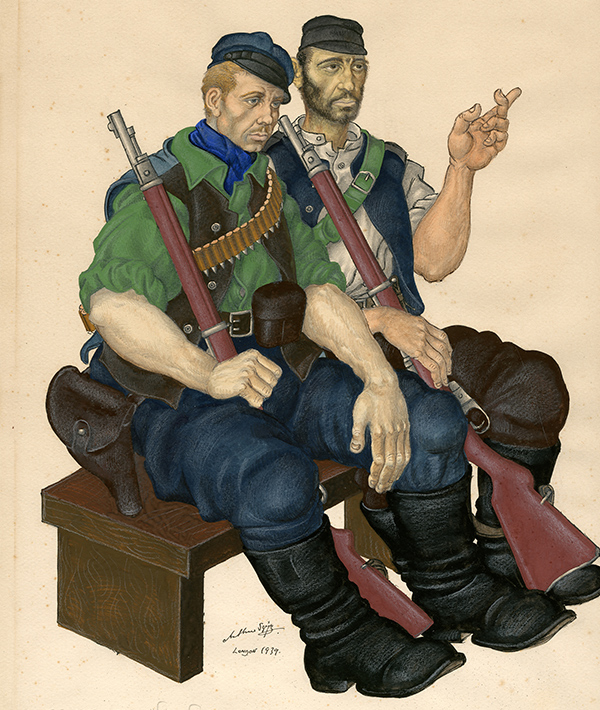
Arthur Szyk, Defenders of Warsaw, 1939, watercolor, gouache, ink, and graphite on paper. Courtesy of Taube Family Arthur Szyk Collection, The Magnes Collection of Jewish Art and Life, University of California, Berkeley.
“They couldn’t wait to see what he’d come up with next,” said Weber. “The images were graphic and carried a real punch. He just wanted to make people aware of what was happening, almost like shaking them out of their complacency: ‘Wake up, people, to what is going on!’”
Fairfield professor of art history and culture Philip Eliasoph, PhD, curator of the Bellarmine Galleries exhibition, said, “Szyk’s depictions of Hitler, Mussolini, Hirohito, and others use the visual language of satire and caricature. It’s a long tradition dating back to Daumier and Goya.”
Szyk created numerous covers for Collier’s and Time, two of the most popular weekly magazines in America during the war years. He also created art for bond drives and production campaigns, all of which put his work in front of millions of Americans on a regular basis.
“Even though all of his magazine covers were topical, the richness and iconography of Szyk brings such depth of story to every image,” said Dr. Eliasoph, who has produced a catalog to accompany the exhibition. “While Szyk may have been speaking for the Jews, he understood the universality of human rights.”
Arthur Szyk was born in Lodz, Poland, and his early graphic talents compelled his father to send him to study art in Paris when he was 15. There, for the next four years, he immersed himself in classical art and the illuminated texts of his Jewish heritage, while also contributing topical cartoons to satire magazines. His stature as a book illustrator continued to grow in Europe, where he traveled and exhibited his work freely throughout the 1920s and early ’30s.
Two events gained Szyk notice in the U.S.: first, in 1934, the Library of Congress exhibited Washington and His Times, 38 watercolors by Szyk depicting events from the American Revolution. Next, at the 1939 New York World’s Fair, 23 of his paintings were included in the Polish Pavilion, all of them celebrating the contributions Poles have made to American history and the strong ties between the two democracies.
![Arthur Szyk, The Silent Partner. “In this game, Adolph [sic], two aces is more than three kings,” 1941, watercolor, gouache, ink, and pencil on paper. Courtesy of Taube Family Arthur Szyk Collection, The Magnes Collection of Jewish Art and Life, University of California, Berkeley.](../../_files/images/2023/summer/1146304511_magazine_summer_2023_soldier-in-art-img_06282023.jpg)
Arthur Szyk, The Silent Partner. “In this game, Adolph [sic], two aces is more than three kings,” 1941, watercolor, gouache, ink, and pencil on paper. Courtesy of Taube Family Arthur Szyk Collection, The Magnes Collection of Jewish Art and Life, University of California, Berkeley.
The work that ultimately gained Szyk worldwide notice and fame was his illustrated edition of The Haggadah, which he’d worked on in the years 1934-36, but which wasn’t published until 1940.
“His masterpiece, The Haggadah, was published in London,” said Dr. Eliasoph. “Printed on vellum, it was at the time the most expensive book ever sold [at $520 a copy]. Even though it made him world-famous, he was just trying to be a servant of the Jewish arts.”
During the early ’30s, Szyk was watching Europe slowly devolve into an antisemitic nightmare. Hitler came to power in Germany in 1933, and four year later the artist relocated his family to London, and by 1940, he had moved to the U.S., splitting time for the rest of his life between New York City and New Canaan, Connecticut.
The Nazi invasion of Poland in September 1939 — the precipitating event of World War II in Europe — was a deeply upsetting wound that became personal when he learned that his mother and brother in Lodz had been sent to the death camps.
Szyk hunkered down and, for the duration of the war, devoted his talents and prodigious energies to the Allied cause, to human rights, and to democracy. His drawings appeared everywhere: in Time, Esquire, The Saturday Evening Post, Collier’s, on posters and postcards, and in war production campaigns for U.S. Steel. In these years, Szyk had more than 25 exhibitions of his work – illustrations in watercolor, gouache, and ink.
Eleanor Roosevelt visited a Szyk exhibition at the Seligman Galleries in New York and was moved to write about the artist more than once in her widely syndicated newspaper column, “My Day.” She referred to him as a “soldier in art” and told her millions of readers, “I know of no other miniaturist doing quite this kind of work. In its way it fights the war against Hitlerism as truly as any of us who cannot actually be on the fighting fronts today. This war is personal for Mr. Szyk. I do not think he will lose it.”
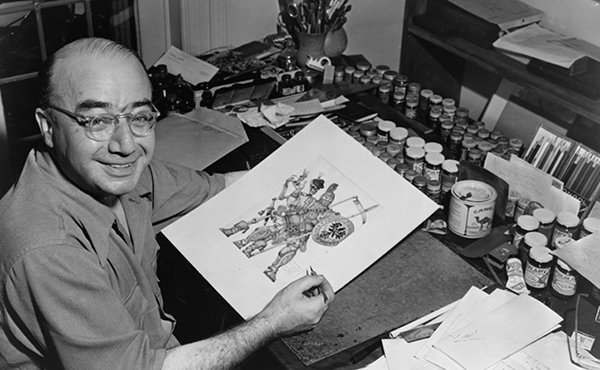
Arthur Szyk, New York City, 1944. Courtesy Irvin Ungar, Curator emeritus, The Arthur Szyk Society.
In Real Times is organized around the theme of human rights. “This theme ties in so well with Fairfield University, where human rights are a core part of the Jesuit mission and curriculum,” said Dr. Eliasoph. “The Jesuits call it social justice and the Jews call it Tikkun olam: ‘to fix the broken world’.”
Along with the exhibition, a two-day symposium (Oct. 4-5), “Arthur Szyk: Art-Propaganda- Memory,” is planned. Speakers include Glenn Dynner, PhD, director of the Bennett Center for Judaic Studies at Fairfield; Gavriel Rosenfeld, PhD, Fairfield history professor and president of the Center for Jewish History in New York City, which is also a co-sponsor of the exhibition; Ellen Umansky, PhD, Fairfield professor emerita of Judaic studies; Francesco Spagnolo, PhD, curator from the Magnes Collection at UC Berkeley; and Stephen Luckert, PhD, senior program curator at the U.S. Holocaust Memorial Museum, who will deliver the keynote address.
“We’re bringing Szyk back home to Connecticut,” said Eliasoph. “When he moved to America in 1940, he and his family first lived in a rental cottage at Compo Beach in Westport; in 1946, he bought a home in New Canaan, where he lived until his death in 1951. Here was this great cartoonist living among us.”
Gavriel Rosenfeld, PHD: President, Center for Jewish History
Last September, Dr. Gavriel Rosenfeld, Fairfield history professor and director of the College of Arts and Sciences’ Judaic Studies program, was named the new president of the Center for Jewish History in New York City. It is a prestigious and well-deserved honor for Dr. Rosenfeld, a specialist in the history of Nazi Germany and Holocaust studies. The Center for Jewish History holds, in its five archives, the world’s largest collection of Jewish history and culture outside Israel (including some of Arthur Szyk’s papers).
The center is also one of the cosponsors of the In Real Times – Arthur Szyk: Artist and Soldier for Human Rights exhibition. Dr. Rosenfeld is a contributor to the catalog and will be a speaker at the symposium.
“My essay for Philip’s book takes a counterfactual approach by pondering, ‘What if Szyk had been born 100 years later? [in 1994 rather than 1894],” said Dr. Rosenfeld. “He’d be creating memes about Putin and Trump. I wrote this in the form of exchanges among fake Twitter tweets.”
The enigma of Szyk fascinates Dr. Rosenfeld. “He was counter-cyclical, following the topical trends even while as an artist he was influenced by Renaissance and medieval illuminated manuscripts,” he said. “At the time, he was seen as old-fashioned, like Norman Rockwell. But he had to be comprehensible to the man on the street to get his message across. And he was.”
Dr. Rosenfeld is currently on a leave of absence from the University, to carry out his duties in New York. “There are many things I miss about Fairfield, mostly teaching instead of fundraising,” he said.
